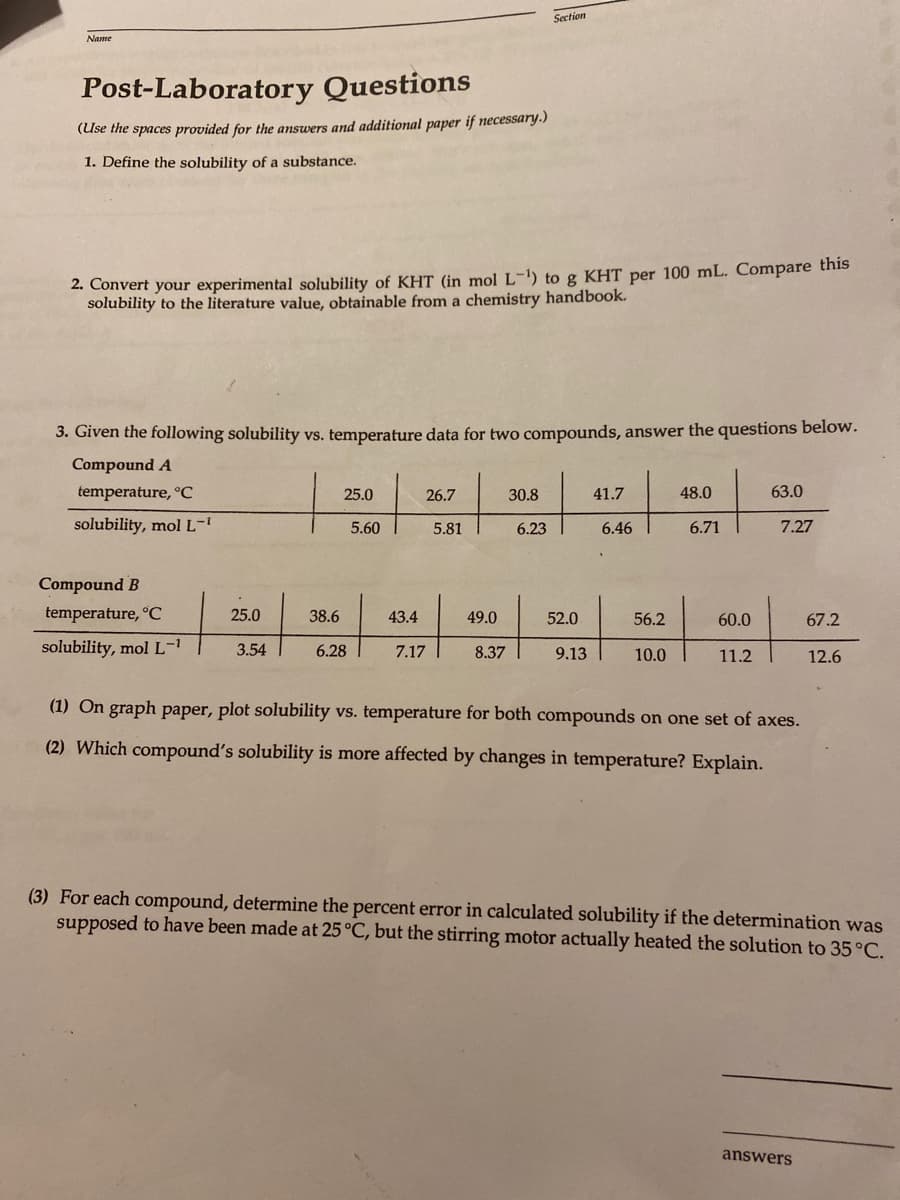Name Post-Laboratory Questions (Use the spaces provided for the answers and additional paper if necessary.) 1. Define the solubility of a substance. 2. Convert your experimental solubility of KHT (in mol L-1) to g KHT per 100 mL. Compare this solubility to the literature value, obtainable from a chemistry handbook. 3. Given the following solubility vs. temperature data for two compounds, answer the questions below. Compound A temperature, °C 25.0 26.7 30.8 41.7 48.0 63.0 solubility, mol L- 5.60 5.81 6.23 6.46 6.71 7.27 Compound B temperature, °C 25.0 38.6 43.4 49.0 52.0 56.2 60.0 67.2 solubility, mol L- 3.54 6.28 7.17 8.37 9.13 10.0 11.2 12.6 (1) On graph paper, plot solubility vs. temperature for both compounds on one set of axes. (2) Which compound's solubility is more affected by changes in temperature? Explain. (3) For each compound, determine the percent error in calculated solubility if the determination was supposed to have been made at 25°C, but the stirring motor actually heated the solution to 35 °C.
Name Post-Laboratory Questions (Use the spaces provided for the answers and additional paper if necessary.) 1. Define the solubility of a substance. 2. Convert your experimental solubility of KHT (in mol L-1) to g KHT per 100 mL. Compare this solubility to the literature value, obtainable from a chemistry handbook. 3. Given the following solubility vs. temperature data for two compounds, answer the questions below. Compound A temperature, °C 25.0 26.7 30.8 41.7 48.0 63.0 solubility, mol L- 5.60 5.81 6.23 6.46 6.71 7.27 Compound B temperature, °C 25.0 38.6 43.4 49.0 52.0 56.2 60.0 67.2 solubility, mol L- 3.54 6.28 7.17 8.37 9.13 10.0 11.2 12.6 (1) On graph paper, plot solubility vs. temperature for both compounds on one set of axes. (2) Which compound's solubility is more affected by changes in temperature? Explain. (3) For each compound, determine the percent error in calculated solubility if the determination was supposed to have been made at 25°C, but the stirring motor actually heated the solution to 35 °C.
Chapter7: Solutions And Colloids
Section: Chapter Questions
Problem 7.44E
Related questions
Question
100%
![Name
Chem
Section
Data Sheet
determination
23°C
23°C
25°C
temperature of filtered KHT
solution, °C
0.04m
concentration of NaOH solution,
mol L-
0.04 m
0.04m
KHT solution
14.9
49-5
final buret reading, mL
initial buret reading, mL
49.9
volume of KHT
used, mL
NaOH solution
28
final buret reading, mL
10
49.8
१.१
49.7
initial buret reading, mL
50
40mL
volume of NaOH
used, mL
number of moles of NaOH used
0014
0014
number of moles of HT titrated
.04
[HT] in KHT solution, mol L-
1.42
1.142
1.142
[K*] in KHT solution, mol L-1
solubility of KHT, mol L-1
average solubility of KHT,
mol L-
Ksp
average Ksp](/v2/_next/image?url=https%3A%2F%2Fcontent.bartleby.com%2Fqna-images%2Fquestion%2F2a471d95-56d0-4af4-bb7d-e52614d6f072%2F3933aee9-92b4-41ff-b0e1-c3141ee90642%2Fgjals5s_processed.jpeg&w=3840&q=75)
Transcribed Image Text:Name
Chem
Section
Data Sheet
determination
23°C
23°C
25°C
temperature of filtered KHT
solution, °C
0.04m
concentration of NaOH solution,
mol L-
0.04 m
0.04m
KHT solution
14.9
49-5
final buret reading, mL
initial buret reading, mL
49.9
volume of KHT
used, mL
NaOH solution
28
final buret reading, mL
10
49.8
१.१
49.7
initial buret reading, mL
50
40mL
volume of NaOH
used, mL
number of moles of NaOH used
0014
0014
number of moles of HT titrated
.04
[HT] in KHT solution, mol L-
1.42
1.142
1.142
[K*] in KHT solution, mol L-1
solubility of KHT, mol L-1
average solubility of KHT,
mol L-
Ksp
average Ksp

Transcribed Image Text:Section
Name
Post-Laboratory Questions
(Use the spaces provided for the answers and additional paper if necessary.)
1. Define the solubility of a substance.
2. Convert your experimental solubility of KHT (in mol L-1) to g KHT per 100 mL. Compare this
solubility to the literature value, obtainable from a chemistry handbook.
3. Given the following solubility vs. temperature data for two compounds, answer the questions below.
Compound A
temperature, °C
25.0
26.7
30.8
41.7
48.0
63.0
solubility, molL-
5.60
5.81
6.23
6.46
6.71
7.27
Compound B
temperature, °C
25.0
38.6
43.4
49.0
52.0
56.2
60.0
67.2
solubility, mol L-1
3.54
6.28
7.17
8.37
9.13
10.0
11.2
12.6
(1) On graph paper, plot solubility vs. temperature for both compounds on one set of axes.
(2) Which compound's solubility is more affected by changes in temperature? Explain.
(3) For each compound, determine the percent error in calculated solubility if the determination was
supposed to have been made at 25°C, but the stirring motor actually heated the solution to 35 °C.
answers
Expert Solution
This question has been solved!
Explore an expertly crafted, step-by-step solution for a thorough understanding of key concepts.
This is a popular solution!
Trending now
This is a popular solution!
Step by step
Solved in 2 steps

Knowledge Booster
Learn more about
Need a deep-dive on the concept behind this application? Look no further. Learn more about this topic, chemistry and related others by exploring similar questions and additional content below.Recommended textbooks for you


Chemistry & Chemical Reactivity
Chemistry
ISBN:
9781133949640
Author:
John C. Kotz, Paul M. Treichel, John Townsend, David Treichel
Publisher:
Cengage Learning

Chemistry & Chemical Reactivity
Chemistry
ISBN:
9781337399074
Author:
John C. Kotz, Paul M. Treichel, John Townsend, David Treichel
Publisher:
Cengage Learning


Chemistry & Chemical Reactivity
Chemistry
ISBN:
9781133949640
Author:
John C. Kotz, Paul M. Treichel, John Townsend, David Treichel
Publisher:
Cengage Learning

Chemistry & Chemical Reactivity
Chemistry
ISBN:
9781337399074
Author:
John C. Kotz, Paul M. Treichel, John Townsend, David Treichel
Publisher:
Cengage Learning

Chemistry: The Molecular Science
Chemistry
ISBN:
9781285199047
Author:
John W. Moore, Conrad L. Stanitski
Publisher:
Cengage Learning